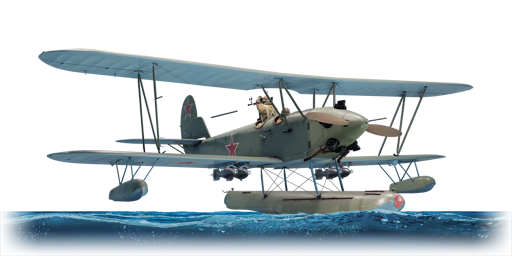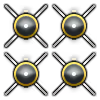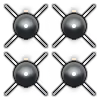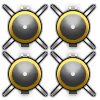


The Po-2M (or Po-2P) was a proposed Soviet biplane intended to be used as a floatplane version of the Po-2. It was developed in the 1940s and was successfully tested at the Khimki water reservoir near Moscow. Due to the requirement to mount a bomb load beneath the lower wings, it was created using a single-float scheme. Apart from that, there were only a few minor differences between it and the land-based version, such as the addition of a spinner to the propeller, hiding the rudder control cables in the fuselage, and a trimming glacis to the elevator. Despite positive test results, it was never put into production. It's very likely that biplane designs were simply considered out of favour at the time, and thus the aircraft never stood a chance.
The Po-2M was introduced during Update "Drone Age" as a reward for the 2022 Project "Overpowered" event. It essentially plays the same as the Po-2 but with some minor improvements. Unfortunately, its status as the slowest plane in the game remains unchanged, but its payload options remain impressive. In comparison to the Po-2, it trades two 50 kg bombs for the ability to carry four more rockets of each type, and even incendiary bombs. The defensive machine gun was also changed to a 7.62 mm DA.
flaps
flaps
flaps
brake
control
| Belt | Belt filling | Armor penetration (mm) at a distance: | |||||
|---|---|---|---|---|---|---|---|
| 10 m | 100 m | 500 m | 1000 m | 1500 m | 2000 m | ||
| T/Ball/Ball/AP-I/AI | 13 | 12 | 7 | 3 | 2 | 0 | |
| AP-I/AP-I/AP-I/API-T | 13 | 12 | 7 | 3 | 2 | 0 | |
| API-T/API-T/API-T/AI | 9 | 8 | 6 | 3 | 0 | 0 | |
| Name | Weight | Slot | ||||||
|---|---|---|---|---|---|---|---|---|
| 4 × | 27.2 kg |  |  | |||||
| 4 × | 60 kg |  |  | |||||
| 4 × | 94 kg |  |  | |||||
| 49.8 kg |  |  |  |  | ||||
| 49.8 kg |  |  |  |  | ||||
| 103.5 kg |  |  | ||||||







 2 x (55 / 100 / 90) %
2 x (55 / 100 / 90) % 
 2 x 100 %
2 x 100 % 

Flight performance | |
|---|---|
Survivability |
|---|
Weaponry | |
|---|---|